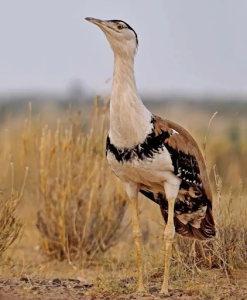07 Sep Bustrad adapted to produce 2 -eggs clutch
GS Paper 3
Mains: Project Great Indian Bustard
Prelims: the great Indian bustard, The desert national park.

Why is it in the news?: The perceived belief and recorded observation of egg-laying habits of the Great Indian bustard have been changed due to recent excessive rain in western Rajasthan.
About Great Indian Bustard
- Great Indian Bustard, scientifically known as Ardeotis nigriceps, locally known as Godovan, is a large bird of the bustard family (Otididae), one of the heaviest flying birds in the world.
- It is the State bird of Rajasthan and is considered India’s most critically endangered bird.
- The great Indian bustard is an inhabitant of dry grasslands and scrublands on the Indian subcontinent; its largest population is found in the Indian state of Rajasthan in the Desert National Park.
- Also, it is found in small populations in Maharashtra, Karnataka, and Andhra Pradesh.
Their reproduction behavior
- Some of the reproductive behaviors of great Indian bustards are known, and the finer details of nesting and mating, as well as migratory activities related to mating and nesting, are thought to vary greatly among populations and individuals.
- They are usually capable of year-round breeding, and for most populations, the breeding season lasts from March through September, which largely sums up the monsoon season.
- They do not return to the same nests year after year, and prefer to create a new one instead, and sometimes prefer to use the nests made in previous years by other great Indian bustards.
- This year it has been observed that 4 female Great Indian Bustards laid two eggs at a time during the current rainy season in the Desert National Park after heavy rainfall in western Rajasthan.
- It is a result of having a diet with additional proteins during the monsoon season.
- The main threats to the Great Indian bustard are bird hunting, intensification of agriculture, and power lines.
Protection status of the Bird and measures are taken.
-
- International Union for Conservation of Nature Red List: Critically Endangered.
- As per the research done by the Wildlife Institute of India, there are around 150 Great Indian Bustards left across the country which includes about 128 birds in Rajasthan and less than 10 birds each in the rest of the States like Gujarat, Maharashtra, Andhra Pradesh, and Karnataka.
- The Great Indian Bustard comes under both in situ and ex-situ conversations.
- In 2019, the WII, in collaboration with the government of Rajasthan and the International Fund for Houbara Conservation, Abu Dhabi, is implementing the ex-situ conservation initiative.
- The Ministry of Environment, Forests, and Wildlife have taken up an initiative on conservation breeding of the Great Indian Bustard in collaboration with Rajasthan, Gujarat, and Maharashtra Forest Departments and technical support from the Wildlife Institute of India, Dehradun implementing the in-situ conservation.
- Species Recovery Programme: It is kept under the species recovery program under the Integrated Development of Wildlife Habitats of the Ministry of Environment, Forests and Climate Change (MoEFCC).
About The Desert National Park
- This National Park is situated in Rajasthan, India, near the towns of Jaisalmer and Barmer.
- The Park is an exceptional example of the ecosystem of the Thar Desert. Sand dunes form around 44% of the Park.
- It covers an area of 3162 km², considered one of the largest national parks.
- The park was gazetted in 1980.
- Common Fauna found in this park are
- The Chinkara or Indian Gazelle (Gazella bennettii) is a common antelope of this region.
- Rare inhabitants are the desert fox, wolf, and desert cat.
- Birds like sandgrouse, partridges, bee-eaters, larks, and shrikes are commonly seen.
- In the winter, the birdlife is augmented by species such as the demoiselle crane and MacQueen’s bustard.
- Common Flora found in this park are
- The park includes open grassland, thorny bushes, and dunes.
- 168 plant species have been recorded in the park. Some species of trees that inhabit the park include Tecomella undulata, Moringa concanensis, Helitropium rariflorum, and Ammannie desertorum.
About project Basturd
- On World Environment Day 2019, the Rajasthan forest department announced its Project Great Indian Bustard.
- In order to, protect the remaining bustard population, the state government of Rajasthan initiated Project Great India Bustard on World Environment Day in 2013, this effort attempted to locate the Indian bustard’s exclusive habitat, fence it off to prevent human intrusion, and provide enclosed breeding habitat.




No Comments